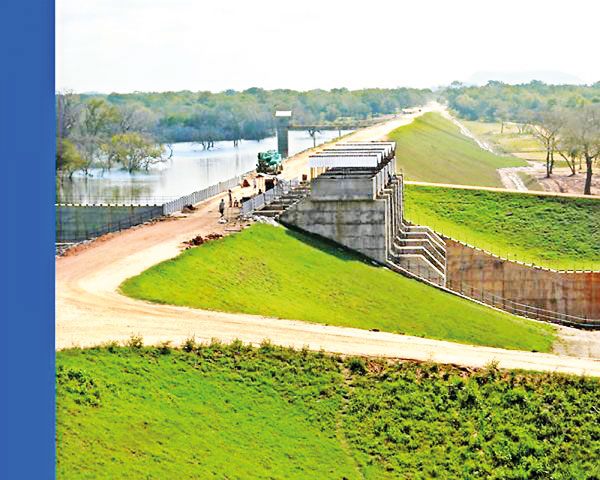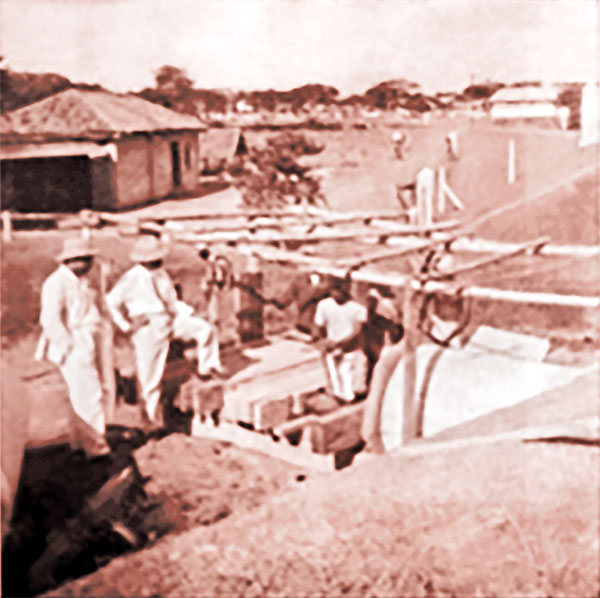News
Keeping the nation verdant and abundant

Weheragala Reservoir Project (Pic courtesy Irrigation Department)
The Irrigation Department of Sri Lanka, established on May 15, 1900 marks 120 years of service to the nation this week. In an attempt at fulfilling the historical excerpt “Not to let a drop of rain water flow in to the sea without first being used for the welfare and livelihood” by the great King Parakumbha, the Department has been providing irrigation water requirements through the construction, operation and maintenance of reservoirs, canals and other irrigation infrastructure; managing and improving irrigation water resources; conducting research on hydrology, geology and other Irrigation Engineering traits; and flood controlling and mitigation activities.
The first reservoirs constructed by the Irrigation Department are considered to be the Iranamadu Reservoir and Unichchi Tank. A few of the most recently completed reservoirs are Yan Oya and Alikota Ara. The Irrigation Department is currently involved in the construction, augmentation, rehabilitation, planning and designing of a number of reservoirs and irrigation infrastructure around the country: The construction of Kuda Oya and Alikota Ara Reservoirs, rehabilitation of Handapanagala Reservoir under the Uma Oya Down-Stream Development Project, and the construction of Morana and Kalugal Oya Reservoirs are some of the projects concurrently carried out by the Department. Farmers in Thanamalwila and the surrounding areas will greatly benefit from the Kuda Oya and Handapanagala Reservoirs, and furthermore, farmers in Mahiyangana, Ampara and the surrounding areas will benefit from the Morana and Kalugal Oya Reservoirs. Moreover, the rehabilitation of Kudawilachchiya Reservoir, the construction of Mundeni Aru, Kumbukkan Oya, Heda Oya Reservoirs and the Potable Water Supply Project in Jaffna are some of the planned projects to provide better service to the nation.
The first head of the Department was Director of Irrigation, H T S Ward, and the second-in-command was the qualified engineer Henry Parker in the British-governed Irrigation Department.
The Colombo and Nilwala flood-controlling projects, the construction of Iranamadu Reservoir, Walawe left bank and Thabbowa Reservoirs, the rehabilitation of Kala Wewa Reservoir, Werugal and Liyangastota Anicuts, and the activities in rural area development around the country were carried out by the Department during the 1920-1929 period. The first tunnel was constructed by the Department in 1925; the Mutwal Tunnel at the Kelani River mouth.
The Irrigation Department’s Hydraulics Division was the first establishment in the country to build the physical models of structures officially opened by Governor Sir Andrew Caldecott on May 21, 1938. The models were erected to verify the hypothesis assumed while planning and design of the real structures.
The repair workshop of the Department at Maradana was shifted to Ratmalana as a Mechanical Branch and expanded by Chief Engineer A H Johnson during 1940-1949. This was considered an achievement for the Department.
The establishment of the Training, Research and Designs Division in early 1940s by eminent engineer R V Burns was carried out after the historical event of recruiting Sri Lankan engineers to the Department in 1941. The Soil Mechanics Laboratory was officially added to the Department as per an idea of the Engineer S G Taylor to study and apply the soil mechanics theories in dam constructions. The numerous construction projects were benefited by this unit and currently it is known as the Engineering Materials Division which is involved in the testing of materials and quality control of Department projects.
The Engineering Geology Division was created to carry out geological deep ground investigation, and to strengthen the foundation sub-grade of the structures. Presently, equipped with modern electronic investigation systems, this unit is capable of drilling 300m holes in the ground to carry out investigations.

The Mutwal Tunnel being constructed by the Department in 1925
The first six-year programme was launched during 1948-1953, with the main objective of facilitating irrigation water to 80,000 acres of new agricultural lands. The completion of the six-year programme in lesser than the estimated time of six years was a great achievement by the Department. The Parakrama Samudra, Minneriya, Huruluwewa, Bathmadilla, Rideebendi Ela, Minipe, Dewahuwa, Gal Oya, Kagama and Walawe irrigation schemes were some of the benefitted areas. Facilitating water flow to the new land extent of 10,000 acres in the Gal Oya Scheme by the erection of nearly 27 miles of main canal, catering irrigation water to the new agricultural land extent of 4,781 acres in Parakrama Samudra Scheme and the enormous development in Elahera, Kanthale, Huruluwewa, Minneriya, Kandalama, Girithale, Padawiya, Hakwatuna Oya Schemes and Nalanda Oya Reservoir during the 1951-1952 period were remarkable.
Engineer Anthony James Princely Ponrajah who worked in the Department from 1951-1985 contributed to the further technical enhancement of the Department by writing several books with technical guidelines. Most of these are still heavily referenced.
The Department head office was shifted to the current location, Bauddhaloka Mawatha, Colombo 7, in 1961, bringing all branches under one roof, fulfilling a long-felt requirement.
Lift irrigation systems, drainage, water management and developments in hydro power were entrusted to the Irrigation Department, apart from its main duties, by 1970. Moreover, the Department also contributed immensely to the preliminary investigation works of the Mahaveli Development Project during 1970-1980. The Gin-Nilwala Flood protection scheme was also completed during this period.
The Kalu Ganga Multi-Scheme Project in 1980-1989, Mau Ara Scheme in 1997 and Minipe Nagadeepa Rehabilitation Project in 1990-1998 were some of the contributions of the Irrigation Department.
In 2000, the Mau Ara Scheme was completed by the sole contribution of Sri Lankan Engineers and Technicians of the Irrigation Department, marking a new turning point in the country’s history. In continuation of the above trait, the Weheragala Reservoir, Gurugal Oya Reservoir, Wemedilla and Attikka Anicuts projects were successfully completed by the Department to provide utmost service to Sri Lankan farmers. The completion of Kekiriobada Reservoir in 2010, Rambukkan Oya Reservoir in 2013, Deduru Oya Reservoir in 2014 and Kalugal Oya Reservoir in 2019 are some of the other great achievements of Sri Lanka’s Irrigation Department.
To fulfil the requirements of further technical, educational and training enhancement, the Irrigation Research Centre was established in 2014 at Jawatta. A new building complex was added to the Irrigation Training Institute, Galgamuwa in 2017. Currently, the Irrigation Training Institute contributes to the training of technical staff of the Department, as well as of private organisations, with modern facilities.
The Irrigation Department serves the nation by providing water to 800,000 acres of paddy lands, 75,000 acres of land with other crops, while serving farmers in 300 irrigation schemes and operating, maintaining and constructing hundreds of reservoirs and irrigation infrastructure around the country.
The “Waari Geethaya”, song of the Irrigation Department, written by Ms Pradeepa Serasinghe, sung by Mr Amarasiri Peries with the music of Mr Nawarathna Gamage, proudly narrates the remarkable chronicle of the Irrigation Department.
“Giant reservoirs; Holding the golden water in golden valleys;
“Fabulous irrigation creations bringing golden crops to the nation.”
This is a tribute to all the engineers, including the Director General of Irrigation, and all the other officers in the Irrigation Department. May they serve the country for a long time with more fabulous irrigation creations, and providing golden crops to the nation.


